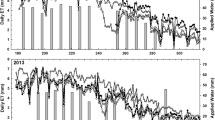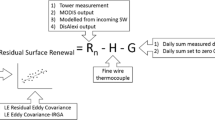Abstract
Turbulent fluxes are key components of surface energy balance. Micrometeorological techniques, such as eddy covariance (EC), are commonly used to estimate sensible (H) and latent (LE) heat fluxes, because they provide direct measurements and do not interfere with the normal crop canopy development. However, EC has technical difficulties, strict size, and surface homogeneity requirements and is relatively expensive. Surface renewal analysis (SRA) is a promising alternative for turbulent flux estimation, because it is more economical, has less-stringent fetch requirements, and can be deployed in heterogeneous canopies or markedly sloped surfaces. Castellví (SRACast) presented a methodology to estimate H using SRA, avoiding the high-frequency wind speed records that are necessary for determining stability and friction velocity, which are then used to calibrate the α parameter (a factor that corrects the nonuniform heating of an air parcel). Instead, an iterative procedure using wind speed recorded using a simple cup anemometer can be used. Here, we estimated sensible and latent heat fluxes and latent heat flux as residual from the energy–balance equation using SRACast during January 2018 and compared the results with EC measurements in a trilled vineyard (heterogeneous canopy), in Pirque, Santiago de Chile. Values of H and LE through SRACast present a high agreement with EC, with slopes (b) of 1.11 and 0.88 and coefficients of determination (R2) of 0.97 and 0.89, respectively. LEres_SRA showed values of 1.60 and 0.80 for b and R2, respectively. Energy balance closure was slightly better for SRA than for EC (b, 0.73 and 0.71; R2, 0.94 and 0.95), proving to be a reasonably good and simpler alternative for turbulent flux estimation.






Similar content being viewed by others
Data availability
Not applicable.
References
Agam N, Kustas WP, Alfieri JG, Gao F, McKee LM, Prueger JH, Hipps LE (2019) Micro-scale spatial variability in soil heat flux (SHF) in a wine-grape vineyard. Irrig Sci 37:253–268. https://doi.org/10.1007/s00271-019-00634-6
Allen RG, Pruitt WO, Businger JA, et al (1996) Chapter 4 Evaporation and transpiration in ASCE handbook of hydrology
Brutsaert W (1982) Evaporation into the atmosphere. Springer Netherlands
Burba G (2013) Eddy covariance method for scientific, industrial, agricultural and regulatory applications: a field book on measuring ecosystem gas exchange and areal emission rates. Li-Cor Biosciences
Burba G, Anderson D (2010) A brief practical guide to eddy covariance flux measurements: principles and workflow examples for scientific and industrial applications. Li-Cor Biosciences
Businger JA (1988) A note on the Businger-Dyer profiles. Boundary-Layer Meteorol 42:145–151. https://doi.org/10.1007/BF00119880
Castellví F (2004) Combining surface renewal analysis and similarity theory: a new approach for estimating sensible heat flux. Water Resour Res 40:1–20. https://doi.org/10.1029/2003WR002677
Castellví F (2012) Fetch requirements using surface renewal analysis for estimating scalar surface fluxes from measurements in the inertial sublayer. Agric For Meteorol 152:233–239. https://doi.org/10.1016/j.agrformet.2011.10.004
Castellví F, Snyder RL (2009) On the performance of surface renewal analysis to estimate sensible heat flux over two growing rice fields under the influence of regional advection. J Hydrol 375:546–553. https://doi.org/10.1016/j.jhydrol.2009.07.005
Castellvi F, Martínez-Cob A, Pérez-Coveta O (2006) Estimating sensible and latent heat fluxes over rice using surface renewal. Agric For Meteorol 139:164–169. https://doi.org/10.1016/j.agrformet.2006.07.005
Castellví F, Snyder RL, Baldocchi DD (2008) Surface energy-balance closure over rangeland grass using the eddy covariance method and surface renewal analysis. Agric For Meteorol 148:1147–1160. https://doi.org/10.1016/j.agrformet.2008.02.012
Foken T (2006) 50 years of the Monin–Obukhov similarity theory. Boundary-Layer Meteorol 119:431–447. https://doi.org/10.1007/s10546-006-9048-6
Gao W, Shaw RH, Paw U KT (1989) Observation of organized structure in turbulent flow within and above a forest canopy. Bound Layer Stud Appl 349–377
Hatfield JL, Baker JM, Viney MK (2005) Micrometeorology in agricultural systems. American Society of Agronomy
Haymann N, Lukyanov V, Tanny J (2019) Effects of variable fetch and footprint on surface renewal measurements of sensible and latent heat fluxes in cotton. Agric For Meteorol 268:63–73. https://doi.org/10.1016/j.agrformet.2019.01.010
Heilman JL, McInnes KJ, Savage MJ et al (1994) Soil and canopy energy balances in a west Texas vineyard. Agric For Meteorol 71:99–114. https://doi.org/10.1016/0168-1923(94)90102-3
Heilman JL, McInnes KJ, Gesch RW et al (1996) Effects of trellising on the energy balance of a vineyard. Agric For Meteorol 81:79–93. https://doi.org/10.1016/0168-1923(95)02312-7
Högström U (1988) Non-dimensional wind and temperature profiles in the atmospheric surface layer: a re-evaluation. Boundary-Layer Meteorol 42:55–78. https://doi.org/10.1007/BF00119875
Hu Y, Buttar NA, Tanny J, Snyder RL, Savage MJ, Lakhiar IA (2018) Surface renewal application for estimating evapotranspiration: a review. Adv Meteorol 2018:1–11. https://doi.org/10.1155/2018/1690714
Incze J, Novák TJ (2016) Identification of extent, topographic characteristics and land abandonment process of vineyard terraces in the Tokaj-Hegyalja wine region between 1784 and 2010. J Maps 12:507–513. https://doi.org/10.1080/17445647.2016.1195295
Ortega-Farias S, Carrasco M, Olioso A, Acevedo C, Poblete C (2007) Latent heat flux over Cabernet Sauvignon vineyard using the Shuttleworth and Wallace model. Irrig Sci 25:161–170. https://doi.org/10.1007/s00271-006-0047-7
Overton J, Murray WE (2011) Playing the scales: regional transformations and the differentiation of rural space in the Chilean wine industry. J Rural Stud 27:63–72. https://doi.org/10.1016/j.jrurstud.2010.07.002
Paulson CA (1970) The mathematical representation of wind speed and temperature profiles in the unstable atmospheric surface layer. J Appl Meteorol 9:857–861. https://doi.org/10.1175/1520-0450(1970)009<0857:tmrows>2.0.co;2
Paw U KT, Brunet Y, Paw UKT, Brunet Y (1991) A surface renewal measure of sensible heat flux density. In: preprints, 20th Conference on Agricultural and Forest Meteorology. pp 52–53
Paw U KT, Qiu J, Su H-B et al (1995) Surface renewal analysis: a new method to obtain scalar fluxes. Agric For Meteorol 74:119–137. https://doi.org/10.1016/0168-1923(94)02182-J
Paw U KT, Snyder RL, Spano D, Su H-B (2015) Surface renewal estimates of scalar exchange. In: Agronomy. AMERICAN SOCIETY OF AGRONOMY, INC, pp 455–483
Poblete-Echeverría C, Sepúlveda-Reyes D, Ortega-Farías S (2014) Effect of height and time lag on the estimation of sensible heat flux over a drip-irrigated vineyard using the surface renewal (SR) method across distinct phenological stages. Agric Water Manag 141:74–83. https://doi.org/10.1016/j.agwat.2014.04.006
Rosa R, Dicken U, Tanny J (2013) Estimating evapotranspiration from processing tomato using the surface renewal technique. Biosyst Eng 114:406–413. https://doi.org/10.1016/j.biosystemseng.2012.06.011
Shapland TM, McElrone AJ, Snyder RL, Paw UKT (2012a) Structure function analysis of two-scale scalar ramps. Part II: Ramp characteristics and surface renewal flux estimation. Boundary-Layer Meteorol 145:27–44. https://doi.org/10.1007/s10546-012-9740-7
Shapland TM, McElrone AJ, Snyder RL, Paw UKT (2012b) Structure function analysis of two-scale scalar ramps. Part I: Theory and modelling. Boundary-Layer Meteorol 145:5–25. https://doi.org/10.1007/s10546-012-9742-5
Shapland TM, Snyder RL, Smart DR, Williams LE (2012c) Estimation of actual evapotranspiration in winegrape vineyards located on hillside terrain using surface renewal analysis. Irrig Sci 30:471–484. https://doi.org/10.1007/s00271-012-0377-6
Snyder RL, Spano D, Paw UKT (1996) Surface renewal analysis for sensible and latent heat flux density. Boundary-Layer Meteorol 77:249–266. https://doi.org/10.1007/BF00123527
Spano D, Snyder RL, Duce P, Paw UKT (1997) Surface renewal analysis for sensible heat flux density using structure functions. Agric For Meteorol 86:259–271. https://doi.org/10.1016/S0168-1923(96)02420-3
Spano D, Snyder RL, Duce P, Paw UKT (2000) Estimating sensible and latent heat flux densities from grapevine canopies using surface renewal. Agric For Meteorol 104:171–183. https://doi.org/10.1016/S0168-1923(00)00167-2
Stanchi S, Godone D, Belmonte S, Freppaz M, Galliani C, Zanini E (2013) Land suitability map for mountain viticulture: a case study in Aosta Valley (NW Italy). J Maps 9:367–372. https://doi.org/10.1080/17445647.2013.785986
Suvočarev K, Shapland TMM, Snyder RLL et al (2014) Surface renewal performance to independently estimate sensible and latent heat fluxes in heterogeneous crop surfaces. J Hydrol 509:83–93. https://doi.org/10.1016/j.jhydrol.2013.11.025
Suvočarev K, Castellví F, Reba ML, Runkle BRK (2019) Surface renewal measurements of H, λE and CO2 fluxes over two different agricultural systems. Agric For Meteorol 279:107763. https://doi.org/10.1016/j.agrformet.2019.107763
Twine TE, Kustas WP, Norman JM, Cook DR, Houser PR, Meyers TP, Prueger JH, Starks PJ, Wesely ML (2000) Correcting eddy-covariance flux underestimates over a grassland. Agric For Meteorol 103:279–300. https://doi.org/10.1016/S0168-1923(00)00123-4
Van Atta CW (1977) Effect of coherent structures on structure functions of temperature in the atmospheric boundary layer. Arch Mech Stosow 29:161–171
Wilson K, Goldstein A, Falge E, Aubinet M, Baldocchi D, Berbigier P, Bernhofer C, Ceulemans R, Dolman H, Field C, Grelle A, Ibrom A, Law BE, Kowalski A, Meyers T, Moncrieff J, Monson R, Oechel W, Tenhunen J, Valentini R, Verma S (2002) Energy balance closure at FLUXNET sites. Agric For Meteorol 113:223–243. https://doi.org/10.1016/S0168-1923(02)00109-0
Acknowledgements
The authors acknowledge Fundo Lo Arcaya, where this research took place. DET was funded by Becas Conicyt, Programa de Formación de Capital Humano Avanzado, Ministerio de Educación de Chile. Partial support also came from form Fondecyt grant 1170429.
Code availability
Not applicable.
Funding
DET was funded by Becas Conicyt, Programa de Formación de Capital Humano Avanzado, Ministerio de Educación de Chile. Partial support also came from form Fondecyt grant 1170429.
Author information
Authors and Affiliations
Contributions
DET and FJM conceived and designed the work. DET collected and analysed the data. FJM and SNL provided intellectually important advice and direction for the work. DET, FJM, and SNL co-wrote the manuscript and approved all edits to the manuscript.
Corresponding author
Ethics declarations
Conflict of interest
The authors declare no competing interests..
Additional information
Publisher’s note
Springer Nature remains neutral with regard to jurisdictional claims in published maps and institutional affiliations.
Rights and permissions
About this article
Cite this article
Tosoni, D.E., Meza, F.J. & Lacy, S.N. Independent estimation of sensible and latent fluxes in a vineyard using improved surface renewal analysis. Theor Appl Climatol 144, 1375–1385 (2021). https://doi.org/10.1007/s00704-021-03612-1
Received:
Accepted:
Published:
Issue Date:
DOI: https://doi.org/10.1007/s00704-021-03612-1




